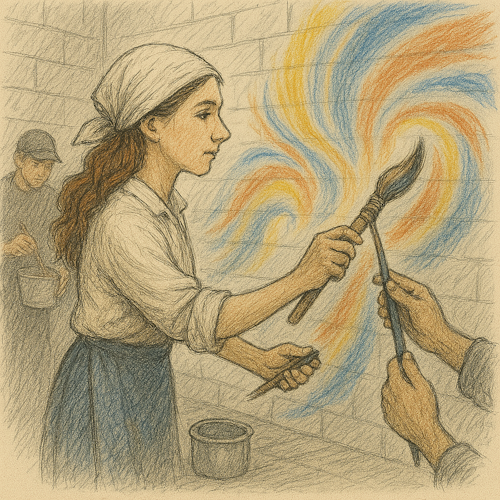The Painter with a Broken Brush
Illustrates Adaptive Creativity, Resourceful Collaboration, Psychological Safety
In the world of Agile, teams often face constraints they did not choose: tight deadlines, missing tools, unclear goals. The challenge is not to eliminate all limitations but to navigate them creatively. This parable explores how individuals and teams can still create meaningful outcomes, even when the ideal tools are out of reach.

There once was a painter named Liora, known in her town for vibrant murals that brought color to gray city walls. Her brushwork was bold and fluid, each line full of motion and intent. One morning, preparing to begin a community art project, she discovered her favorite brush had snapped in half. The handle was cracked, the bristles loose.
She searched for a replacement, but no other tool felt quite right. Her apprentices offered to delay the project, but the wall was ready, the community waiting. Liora paused. Then she picked up the broken brush, wrapped the handle in cloth, and braced it with twine. It was imperfect, but it would have to do.
At first, her strokes were awkward. The brush wobbled. Lines blurred. She frowned. Then, slowly, she adapted. She leaned into the motion, let the looseness inspire curves she would not have chosen. She asked one apprentice to steady the handle. Another began mixing colors to match the flow. Together, they adjusted. Together, they painted.
The finished mural was not what Liora had originally envisioned. But it was alive. Its rhythm was new. When people walked by, they paused. Not because it was flawless, but because it was surprising.
Years later, when asked how she painted her most beloved mural with a broken brush, Liora smiled and said, "Sometimes, the cracks invite us to listen differently."
Lessons Learned
Constraints Spark Creativity
Liora could have postponed the project or insisted on the perfect tool. Instead, she embraced the limitation and discovered new forms of expression. Agile teams often face imperfect conditions. Working within constraints invites innovation and shared ownership.
Adaptation Outweighs Precision
Rather than force the old technique, Liora evolved her style. Agile teams that cling to plans or practices that no longer serve them miss opportunities to grow. The ability to adapt in the moment is more valuable than perfect execution of outdated plans.
Collaboration Strengthens Capability
Liora leaned on her apprentices not as helpers, but as co-creators. Agile teams thrive when members shift from individual heroics to mutual support. Sharing responsibility builds resilience.
Let Go of the Original Plan
The mural was different than expected, yet more powerful because it responded to the moment. Agile outcomes emerge from discovery, not just delivery. Plans are useful, but clinging too tightly limits what's possible.
Psychological Safety Enables Experimentation
Liora did not hide the broken brush. She modeled transparency and curiosity. Her apprentices felt safe to contribute. Teams do their best work when they can experiment openly and learn without fear.
Coaching Tips
- Use the Parable to Address Perfectionism: Invite teams to reflect on times when flawed conditions led to surprising results. Help them see imperfection as a path to growth.
- Reinforce Team Interdependence: The story highlights how leaning on others is a strength, not a weakness. Use it to facilitate conversations about team roles and support systems.
- Challenge Rigid Planning Mindsets: Encourage Product Owners and stakeholders to embrace evolving outcomes. Plans provide direction, not a destination.
- Model Resilience: Share this story when teams are discouraged by lack of ideal resources. It can shift the focus from what's missing to what is still possible.
Agility does not mean having perfect tools. It means learning to respond when the tools fail. Like Liora, Agile teams build greatness not in the absence of struggle, but through it. The beauty is not despite the broken brush. It is because of it.


